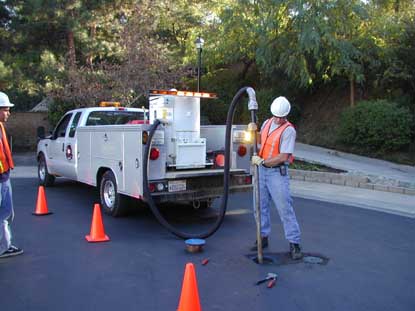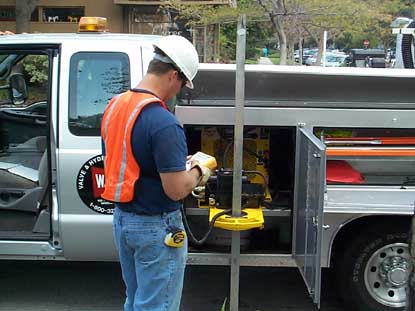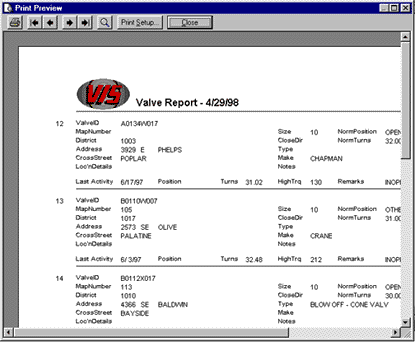Valve Exercising & Hydrant Service Offers Water Utilities Multiple Benefits
Today water utilities are finding themselves hard pressed to undertake systematic valve maintenance and exercising programs. Perceived expense, manpower requirements and budget pressures, as well as daily construction and repair demands are real roadblocks to preventative maintenance goals.
By Tracy Fabre, Managing Editor, Water Online
Contents
Vacuum system cleans mud-, water- and debris-filled valve boxes
Automated valve operators fully exercise valves, provide complete system data details
Interactive valve management software program downloads data to utility's database
Recently, a water utility in the western United States needed to verify that its distribution system was operating at peak performance and valve records were current. Since the utility's distribution system covered a very large area, it was decided that the fastest and most economical way to complete the valve-exercising project was to hire a contractor. Wheeling, Illinois-based E.H. Wachs Companies and its valve maintenance vehicles and factory-trained service technicians were brought in to locate, map, clean out, and exercise all the valves and hydrants in the system.
The scope of work included:
- Locating each valve to be exercised
- Providing required traffic control
- Verifying valve location with district maps
- Assigning an ID number for each valve
- Cleaning valve boxes and painting valve box lids
- Operating/exercising 90 to 100 valves daily
- Documenting valve location, number of turns, size, turn direction, and depth
- Furnishing a database that would be compatible with client's software
- Identifying valves that were inoperable, broken, leaking, etc.
Vacuum system cleans mud-, water- and debris-filled valve boxes (top)
Using a Trav-L-Vac utility vacuum system, service crews were required to clean out over two-thirds of the valve boxes in the system, which consisted of water, mud and debris. This vacuum system is capable of handling solid and liquid debris for applications such as valve box cleanout, the cleanup of sludge and industrial spills, etc. Various models of the system are capable of vacuuming water at 100 to 350 gallons per minute (gpm), and lifting solids up to 90 lbs.

Crews use the vacuum system to cleanout valve boxes, which often are filled with water, mud and debris.
Automated valve operators fully exercise valves, provide complete system data details (top)
After clean out was completed, all the valves were operated by turning them to the fully closed position, reversing to the fully opened position, then repeating twice to assure a fully exercised valve. The valves were then kept in the open position. This process, integrated with ValveCard 1.2 software, allowed automated valve operators to capture data such as number of revolutions turned, torque applied and other characteristics to a permanent valve record, assuring accurate documentation.

From the handheld controller, operators are able to record valve information, exercise valves and input valve location and other vital information.
Interactive valve management software program downloads data to utility's database (top)
The ValveCard software, an interactive valve management program that stores and organizes valve data, allows water utilities to manage their valve distribution system from a desktop PC. It can perform queries regarding valve properties, location, activities and conditions as well as interface with GIS and map files. This system allows the user to maintain a complete valve profile and valve activity history, import ESRI shape files, use map files for spatial selection of field maintenance to be performed, and more.
The product provides for valve identification, valve data, location, special notes and information as well as the ability to construct and save valve and activity queries via a query builder. Valve activity data such as torque, turns, direction, condition, date, and time can be transferred from the automated valve operator's data collection controller directly to the utility's system database.

The above is a snapshot of a report generated from the ValveCard software. The software allows utilities create reports showing the time, location and condition of valves at the time the exercising process took place.
The software can be used for water utilities that need to create valve inventory databases, that require a secure system to input, store and analyze valve data, or want to collect valve information directly from each valve in a system. Water utilities that need to operate and exercise valves in their system and record this information, or those needing to monitor the system and keep it operational at all times also can use this program.
The accumulated valve data was then uploaded to the utility's information system, from which the utility was able to generate a variety of custom lists and reports to support future field maintenance. The status information data was then used repair problems and improve water flow.
By employing these valve-exercising services, the utility was able to have confidence that its valve boxes were thoroughly cleaned and valves precisely exercised. It also didn't have to worry about the potentially overwhelming number of manpower hours required for the job as Wachs' factory-trained valve servicing technicians performed the maintenance and ensured safe operation. Finally, the utility received complete electronic documentation of each valve in the distribution system that was operated and serviced.
For more information on these products and services, contact E.H. Wachs Companies at 847-537-8800 or 1-800-323-8185.
